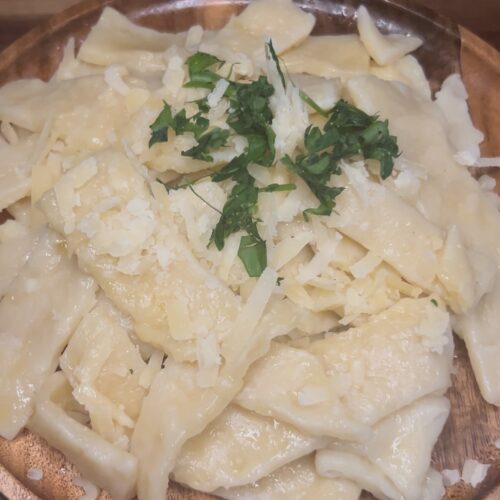When we think of mac and cheese, we often picture creamy, golden pasta covered in melted cheese, a dish synonymous with comfort food. But long before boxed macaroni dinners or baked casseroles, medieval Europe had its own version of this timeless classic: Macrows, a dish recorded in the 14th-century English cookbook The Forme of Cury—one of the oldest known recipe collections in English.
At its core, Macrows was a simple yet elegant dish of hand-rolled pasta, cheese, and butter, bearing a striking resemblance to modern lasagna or buttered noodles with Parmesan. The recipe instructs cooks to roll out thin sheets of dough, cut them into strips, and boil them until soft.
Once cooked, the pasta was layered with grated cheese and butter, much like medieval losyns (an early precursor to lasagna). There were no béchamel sauces or spices—just the richness of cheese and butter melting together over the fresh, hand-cut noodles.
How Was Macrows Eaten?
Unlike modern pasta dishes, which are neatly twirled onto forks, Macrows was likely eaten with a wooden stick or knife—a common practice in medieval dining, where individual utensils were still rare.
Forks had not yet become widespread in England, so diners either used their hands, a broad knife, or wooden skewers to scoop up the buttery, cheesy noodles. Given that feasting tables were often covered with thick bread trenchers instead of plates, it’s easy to imagine diners pulling apart soft, cheese-laden strips with their fingers or cutting them into bite-sized portions.
Parmesan and the Medieval Love of Aged Cheese
One of the most intriguing aspects of Macrows is the cheese selection. The original recipe does not specify a type, but medieval England had access to hard, aged cheeses similar to Parmesan (Parmigiano-Reggiano), which was already being produced in Italy by the 13th century and traded throughout Europe.
Wealthier households might have used imported Parmesan-style cheese, while commoners likely used English hard cheeses like Cheddar or Cheshire, which also grated well. The cheese added a nutty, salty sharpness to the dish, balanced by the richness of the butter.
The Taste Profile of Macrows
Unlike today’s mac and cheese, which relies on milk-based sauces and seasonings, medieval Macrows had a simpler, more rustic taste. The pasta was soft but slightly chewy, the cheese was sharp and savory, and the butter added a luxurious mouthfeel.
Without additional spices or herbs, the dish depended entirely on the quality of the cheese and butter for flavor. It was rich, hearty, and satisfying—perfect for a medieval feast.
Though Macrows faded from popularity as pasta-making techniques evolved, it remains a fascinating glimpse into the culinary history of mac and cheese. In many ways, it represents the earliest form of a dish that would eventually become a global favorite. So next time you enjoy a warm bowl of mac and cheese, remember—you’re partaking in a tradition that dates back over 600 years.
Macrows Recipe

Macrows: Medieval Cheese Pasta
Ingredients
For the Dough (Fresh Medieval Pasta)
- 1 cup flour preferably whole wheat, as used in medieval times
- ¼ tsp salt
- ¼ cup water adjust as needed
For the Dish
- ½ cup grated cheese Parmesan or an aged English cheese like Cheshire or Gloucester
- 2 tbsp butter or animal fat for authenticity
- 1 tbs chopped Parsley optional for garnish
- Salt to taste
- Water for boiling
Instructions
Step 1: Make the Pasta Dough
- Mix flour and salt in a bowl.
- Gradually add water (and egg, if using), kneading until a firm dough forms.
- Roll out into a thin sheet (~1/8 inch thick).
- Cut into long, thin strips (similar to lasagna or fettuccine).
- Let rest while you prepare the other ingredients.
Step 2: Cook the Pasta
- Bring a pot of water to a boil, adding a pinch of salt.
- Drop in the freshly cut pasta and boil for 2–3 minutes (fresh pasta cooks quickly).
- Drain and set aside.
Step 3: Assemble the Dish
- In a serving dish, layer pasta, butter, and grated cheese, repeating as needed.
- Ensure cheese is both beneath and on top, as instructed in the original recipe.
- Bake for 5-10 minutes at 350, or until cheese melts.
Step 4: Serve Warm
- Serve immediately while the cheese and butter are still melty.
- Garnish with chopped Parsley.
- Traditionally, this would be eaten with a wooden stick or knife instead of a fork.
Video
Notes
- Hand-rolled pasta creates a more rustic texture: Medieval pasta was made by rolling thin sheets of dough by hand, which resulted in a slightly chewier texture than modern machine-pressed pasta.
- Cheese selection affects the flavor: The original recipe does not specify the type of cheese, but medieval England had access to Parmesan (imported from Italy) and local cheeses like Cheshire or Gloucester. Choosing an aged, hard cheese will give the dish an authentic nutty-salty taste.
- Layering with butter mimics an early lasagna: The instruction to “cast butter beneath and above” suggests that butter was used to prevent sticking and add richness, much like later lasagna or buttered noodles.
